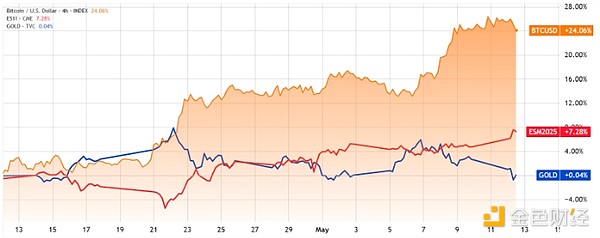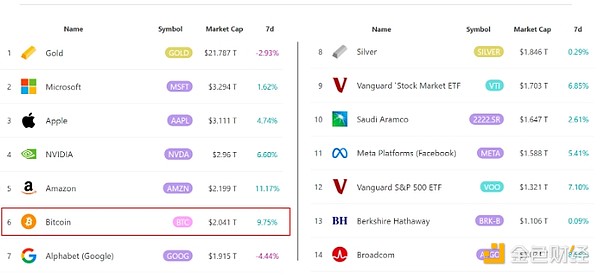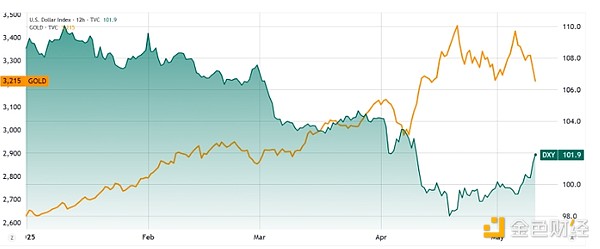Author: Marcel Pechman, CoinTelegraph; Compiler: Deng Tong, Golden Finance
Summary:
After China and the United States reached an agreement that could end the current trade war, investors turned to the stock market, and Bitcoin lagged behind.
The macroeconomic environment is shifting from gold investment to the stock market.
On May 12, the price of Bitcoin reached $105,720, the highest point in more than three months, but then failed to maintain its upward momentum. It is worth noting that the price of Bitcoin fell to $102,000, and the tariff conflict between China and the United States had eased. This puzzled traders as to why Bitcoin would react negatively to seemingly positive developments.
The 90-day truce reduced import tariffs, and U.S. Treasury Secretary Scott Bessant noted that the agreement could be extended as long as both sides make sincere efforts and engage in constructive dialogue. According to Yahoo Finance, topics discussed included "currency manipulation," "steel price dumping," and semiconductor export restrictions.

Bitcoin/USD (orange) versus S&P 500 futures (red) and gold (blue). Source: TradingView / Cointelegraph
Bitcoin's recent lack of momentum is partly due to its 24% gain over the past 30 days, while S&P 500 futures are up 7% and gold prices are flat over the same period. Investors believe that further divergence between Bitcoin and traditional markets is unlikely, especially considering that its 30-day correlation with the stock market remains as high as 83%.
In addition, Bitcoin's market capitalization has now surpassed silver and Google to become the world's sixth-largest tradable asset.

The world's largest tradable asset: USD. Source: 8marketcap
The news that Strategy acquired another 13,390 BTC between May 5 and May 11 also sparked investor concerns. With BlackRock and Strategy holding a combined 1.19 million BTC, or about 6% of the circulating supply, some traders are concerned that Michael Saylor’s firm is largely responsible for supporting the price of Bitcoin.
Critics such as Peter Schiff have predicted that Strategy’s rising average purchase price could eventually lead to losses and force the firm to sell some of its holdings to cover borrowing costs. However, that scenario seems unlikely as the firm has doubled its limit for capital increases, which include $21 billion in equity and $21 billion in debt.
Macroeconomic Events Favor Stocks, Not Gold, Bitcoin Price Stalls
While traders often focus on Bitcoin-specific events, the most likely reason for Bitcoin’s weakness around $105,000 is broader macroeconomic conditions. While the tariff pause is directly positive for the stock market, the impact on scarce assets such as Bitcoin is slightly negative. For example, gold prices fell 3.4% on May 12 as demand for safe-haven assets declined.

Gold/USD (left) vs. US Dollar Index (right). Source: TradingView / Cointelegraph
Gold typically has an inverse relationship with the US Dollar Index (DXY), which climbed to its highest level in 30 days on May 12. The stronger dollar suggests growing investor confidence despite a 0.3% decline in first-quarter gross domestic product (GDP) and a 6.1% month-over-month increase in pending home sales in March.
The lack of investor confidence as Bitcoin prices approach $105,000 is at least partly due to reduced demand for scarce assets as investors see the stock market as a more direct beneficiary of the U.S.-China trade deal. Lower import tariffs mean higher revenue for companies and potentially better profit margins.
Given the staggering $2 billion in inflows into U.S. spot Bitcoin exchange-traded funds (ETFs) between May 1 and May 9, the likelihood of Bitcoin prices falling below $100,000 remains low. After a 24% monthly gain, steady demand for Bitcoin suggests institutional adoption rather than retail investor FOMO, which is a very positive sign for Bitcoin prices.
 Kikyo
Kikyo







